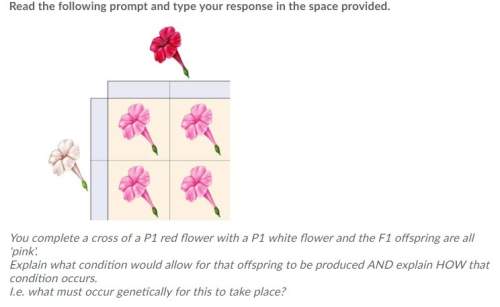
Biology, 27.09.2019 03:00 carolhubble
The image above is of a kelp bed. in ideal conditions, kelp can grow up to 18 inches per day. in stark contrast to the slow-growing corals, the giant kelp canopies tower above the ocean floor. like trees in a forest, these giant algae provide food and shelter for thousands of fish, invertebrates, and marine mammal species. storms and weather events, like el niño, can tear and dislodge the kelp, leaving a tattered forest to begin its growth again each spring. sea otters and sea urchins play critical roles in the stable equilibrium of this ecosystem. sea urchins graze kelp and may reach population densities large enough to destroy kelp forests at the rate of 30 feet per month. urchins move in herds, and enough urchins may remain in the location of a former kelp forest to stop any regrowth. in the scenario above, identify the keystone and foundation species. infer what might happen if the keystone species were greatly reduced. a) keystone species is the kelp. if the kelp is reduced or destroyed the basis for the entire ecosystem is destroyed as is the ecosystem. b) keystone species is the kelp. it is the foundation for this ecosystem. if destroyed it would be replaced by another producer to establish a different ecosystem. c) keystone species is the sea otter. sea otters, playing a critical role in containing the urchin populations, prey on urchins and thus control the numbers of kelp grazers to maintain the forest. d) keystone species is the sea urchin. if the sea urchin species is greatly reduced by an increase in the sea otter population, the kelp beds would continue to grow unchecked and other populations of herbivores would grow.

Answers: 3
Another question on Biology

Biology, 22.06.2019 03:30
Q: a: in sexually reproducing animals, once fertilization of the egg takes place, the exists as a single cell until cell division begins
Answers: 2

Biology, 22.06.2019 04:00
Indicate the coat color and the proportion of offspring with that color for each of the following crosses of rabbits. assume all are homozygous. albino x albino a) 1/4 chinchilla, 3/4, agouti b) 3/4 albino, 1/4 chinchilla c) all albino
Answers: 3

Biology, 22.06.2019 09:30
Juan and carol were studying invertebrates in biology. they knew that segmented or earth worms preferred a dark, moist habitat. during this lab, they would be investigating the responses of organisms called planaria or dugesia tigrina. these were simple flatworms that still had a one-way digestive system and a very simple nervous system. juan and carol placed the planaria in a petri dish containing cool, distilled water that was partially covered with black paper. they shined a light on the dish. next, they removed the paper and placed a small amount of chicken liver at one end of the dish. they added a few large salt crystals to the water. finally, they added drops of hot water to the cool water in the petri dish. their results can be seen in the data table. according to their experiment, all but one conclusion is valid.
Answers: 1

Biology, 22.06.2019 12:30
Which of the following is true of metabolism in its entirety in all organisms? a) metabolism depends on a constant supply of energy from food. b) metabolism uses all of an organism's resources. c) metabolism consists of all the energy transformation reactions in an organism. d) metabolism manages the increase of entropy in an organism.
Answers: 1
You know the right answer?
The image above is of a kelp bed. in ideal conditions, kelp can grow up to 18 inches per day. in sta...
Questions

Arts, 24.08.2021 21:00







Social Studies, 24.08.2021 21:00

Mathematics, 24.08.2021 21:00




Mathematics, 24.08.2021 21:00


Biology, 24.08.2021 21:00








